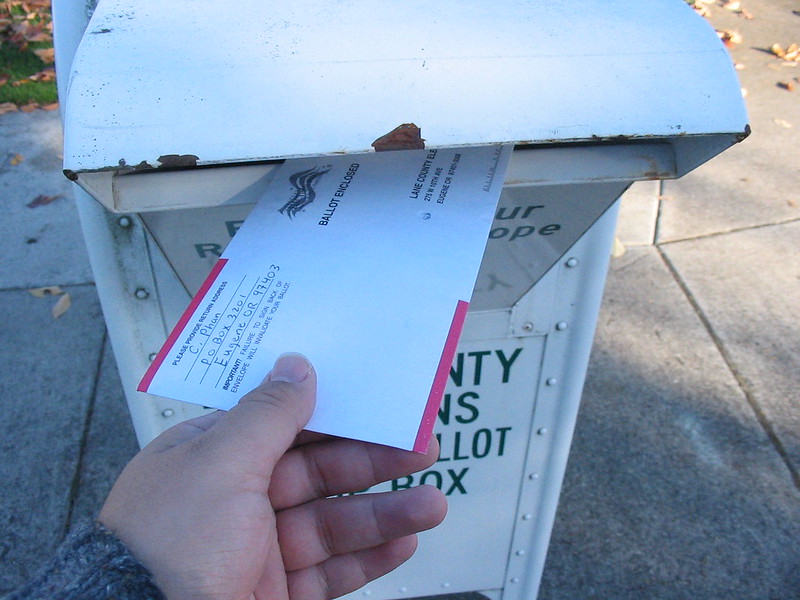While the numbers of COVID-19 cases are increasing globally, proving that the pandemic is far from being contained, the United States has apparently had more difficulty handling the virus than any other developed country. With more than 6 million confirmed cases, the idea of thousands of Americans crowding the polling stations in November seems particularly hazardous. On April 7th, the Spring Election and Presidential Preference Primary held in Wisconsin revealed the difficulty of maintaining safe in-person voting conditions, providing a glimpse of what problems might face the presidential election on November 3rd. Voters, some wearing face masks or hazmat suits, lined-up in endless queues at their local polling station, while the most vulnerable citizens had to prioritize their health over their right to vote. “I was told by my doctor to stay in and stay away from crowds. That’s why I didn’t go. Plus, I have no ride. No transportation. I just can’t take the risk,” explained Mrs. Corders, a 70-year-old resident of Milwaukee, Wisconsin. The ballot took place in spite of Governor Tony Evers’s attempt to delay the election because there was not “a sufficiently safe way to administer in-person voting”, which was strongly opposed by Republicans.
Given these challenges posed by the pandemic, a considerable segment of the American electorate invokes postal voting as the most realistic and viable alternative to in-person voting. According to a national survey conducted between July 31stand August 2nd, 2020, 58% of respondents declared being in favour of allowing voters to cast their votes by mail. However, voting by mail proved to be polarizing among the electorate: while 81 percent of Democrats and 57% of independents declared being in favour of voting by mail in November, only 33% of Republican respondents felt the same way. As most American states are progressively making the administrative changes to allow citizens to vote remotely, voting by mail is still vehemently opposed by President Donald Trump and a significant share of the Republican Party.
Is Voting By Mail Safe?
The first argument Trump appeals to in order to discredit voting by mail is the spectre of electoral fraud. On May 26th, Trump tweeted, “There is NO WAY (ZERO!) that Mail-In Ballots will be anything less than substantially fraudulent. Mailboxes will be robbed, ballots will be forged & even illegally printed out & fraudulently signed,” a claim unsupported by evidence, and one that prompted Twitter to add a warning label encouraging users to “get the facts about mail-in-ballots.”
As with any other voting procedure, voting by mail suffers from some vulnerabilities. However, it also includes built-in anti-fraud protections making it challenging to impersonate voters or steal ballots. Only registered voters can request an absentee ballot, and voters’ signatures are required on their return envelopes, which are examined by the election authorities. People who attempt to abuse the mail-in ballot system can be charged with fines or even face prison time for election fraud. Overall, electoral fraud in the United States is extremely rare, and although voting by mail comes with its share of security risks, there are very few fraud cases involving this model.
Five American states–Colorado, Hawaii, Oregon, Washington and Utah–already conduct their state elections by mail, without reporting widespread fraudulent practices. They embraced universal voting by mail, which means ballots are mailed to all voters across their respective states, in contrast to absentee balloting, for which the voter must request a mail-in ballot. In other countries, as well, voting by mail is commonly done, without reports of major security breaches. In Switzerland, voters receive a ballot three weeks ahead of the election day and can send their vote anytime during this period or cast their vote at their local polling station. A study conducted in 2007 even showed that Switzerland experienced higher turnout rates as a result of the implementation of postal voting. Moreover, other countries, such as Australia and South Korea, have encouraged voting by mail in order to help curb the pandemic.
Does Vote-By-Mail Benefit Democrats At The Expense Of Republicans?
While the security argument does not hold up under rigorous examination, another issue some Republicans have raised is the alleged inherent partisan bias of voting by mail. Trump declared that it, “for whatever reason, doesn’t work out well for Republicans,” implying that this mail-in voting process gives an advantage to the Democrats. Once again, this claim is not supported by any substantial evidence. A study conducted by scholars at Stanford University and published in 2020, showed that postal voting does not benefit one party over another. Based on elections between 1996 and 2018, the study concluded that “vote-by-mail modestly increases overall average turnout rates,” but without affecting either party’s share of turnout or vote share.
It can be surmised that Republicans may fear that voting by mail will increase turnouts in social groups that typically vote less than others but traditionally lean towards the Democratic Party – mainly young and low-income groups, as well as minorities. However, allowing people to cast their vote remotely will also enable senior citizens, a demographic usually leaning towards conservatism, who might be physically handicapped or without transportation, to exercise their right to vote. Therefore, mail-in ballots could benefit both parties by mobilizing groups that might not be able to cast their vote at a polling station, thus allowing more Americans to exercise their constitutional rights.
Can All American States Pull Off Mail-In Ballots In November?
Even though voting by mail appears to be a viable alternative to in-person voting this autumn, this model comes with its share of technical difficulties. Preparing the United States to conduct its presidential election in November by mail is a big adjustment in a short period of time, raising major logistical considerations. Mailing ballots to the entire country requires equipment to print and process these ballots. This major shift also incurs some costs, such as providing voters with a postage-paid return envelope. Switching to a mail-in election also requires personnel to be trained in processing ballots, and voters to be educated about the procedure. Finally, this shift would also represent a difficult task for the U.S. Postal Service (USPS), which could be overwhelmed by the sheer volume of absentee ballots and experience some difficulties in processing these ballots in time for the election. As the main facilitator of voting by mail, the USPS’s abilities have become a significant political issue over the past weeks. This can be inferred by the president’s attempt to block USPS funding, as well as by postmaster general Louis DeJoy’s cost-cutting measures that would lead to major slowdowns for the election in November.
Voting by mail could be a workable alternative to in-person voting in the U.S. presidential election of 2020. Although this procedure could be challenging to implement, primarily for the states that are not already familiar with it, it would allow American citizens to exercise their right to vote without magnifying their risk of contracting COVID-19. Contrary to some of President Trump’s assertions, holding the election by mail would not entail foreign interference nor electoral fraud, and would not necessarily benefit Democrats. Trump’s vigorous opposition to voting by mail in November, ostensibly on behalf of security concerns and the preservation of American democracy, seems rather to be rooted in political considerations. The president is even suggesting postponing the election, an alternative jeopardizing U.S. democracy even more than preventing American citizens from voting remotely.
Cover image: A voter returns his vote-by-mail ballot in the 2006 general elections in Lane County, Oregon, by Chris Phan (2006) via Flickr. Licensed under CC BY 2.0.
Disclaimer: Any views or opinions expressed in articles are solely those of the authors and do not necessarily represent the views of the NATO Association of Canada.




